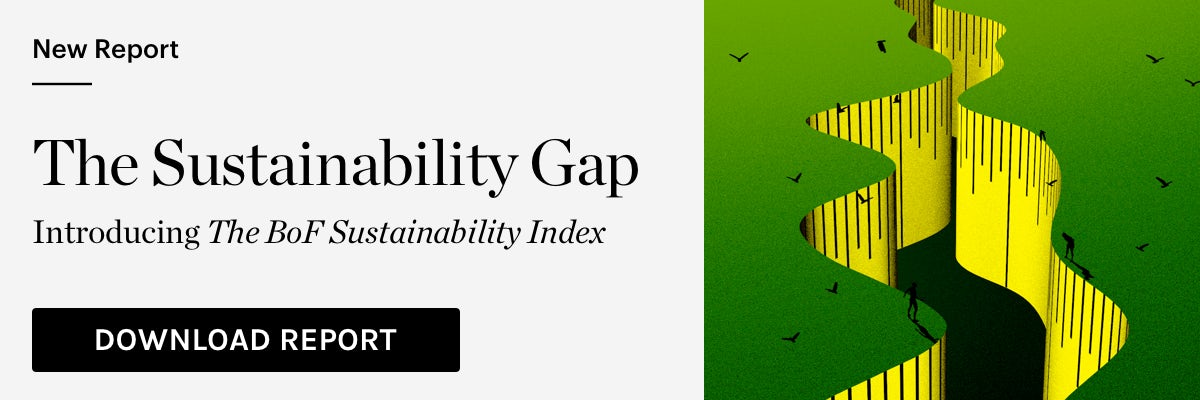The BoF Professional Summit: Closing Fashion’s Sustainability Gap | BoF Professional, News & Analysis
“You never stop learning when you work in sustainability,” Stella McCartney said in her closing remarks for The BoF Professional Summit: Closing Fashion’s Sustainability Gap.
The pioneering designer’s keynote rounded out a series of talks untangling one of the fashion industry’s most critical challenges.
Growing awareness of fashion’s contribution to increasingly urgent social and environmental problems is ratcheting up pressure on brands to act from consumers, investors and regulators. Climate change is a real business risk.
The Summit’s conversations laid out clear action points to help the industry make the systemic changes that will be required over the coming decade if it is to remain aligned with global efforts to limit climate change and meet sustainable development goals.
“It’s very simple but today it seems very radical, and really it could be the future of fashion,” McCartney told BoF chief executive and editor-in-chief Imran Amed of budding sustainable practices, such as the use of innovative materials and regenerative agriculture.
It’s an attitude many more in the industry will need to adopt — fast. According to The BoF Sustainability Index, fashion is not moving fast enough to meet environmental and social goals for the coming decade. The analysis of 15 of the industry’s largest companies examined performance across six key categories, which served as a framework for the summit.
In the conversations covering transparency, emissions, water and chemicals, materials, workers’ rights and waste, certain themes came up again and again. One central message: the fashion industry needs to fundamentally shift its financial priorities to incorporate the real environmental and social cost of its current business model.
The change “requires investment and commitment,“ McCartney said. But brands that don’t engage will find themselves on the wrong side of the market in the long term.
“I don’t think we can rely on our industry to commit to this, as much as we can rely on tomorrow’s customers insisting that this is the only thing they’re going to invest in,” she added.
The BoF Sustainability Index
Transparency: Tackling Misinformation and Bad Data
The fashion industry’s lack of transparency is a fundamental barrier to efforts to operate more sustainably. Although pressure on companies to provide more tangible data about their environmental and social impact is mounting, progress is marred by disinformation and vague claims.
Most companies have very limited visibility over how and where their products are put together, let alone the working conditions or environmental output of the farms and factories involved. That opacity allows problems in the supply chain to go undetected or ignored.
“There is a level at which the lack of transparency is working for these companies, because it allows them to perpetuate the status quo,” said Linda E. Greer, a global fellow at the Institute of Public and Environmental Affairs.
One solution is tougher regulation. In the meantime, companies should start by building a better picture of their most pressing environmental pain points: the emissions generated by their manufacturing base.
“If you’re not doing that, you’re just not in the game,” said Greer.
Emissions: Solving Fashion’s Climate Crisis
Many of the industry’s biggest players have committed to ambitious targets to cut their greenhouse gas emissions by the end of the decade, but making good on those commitments is another matter.
“We’ve made a lot of progress in this space, [but there] is a gap between where we’re going and what we’re doing to get there,” said Hannah Phang, head of marketing and advocacy at Futerra.
Meaningful action on carbon emissions will require industry-wide collaboration. “Fundamentally, this is a problem which no individual company can solve on its own,” said Laila Petrie, chief executive at sustainability consultancy 2050. “We have all sorts of intractable issues around infrastructure, around incentives, around policy and no one actor can really operate within that system without being affected by it.”
What’s more, the industry will need to move beyond tools like carbon offsetting, focusing instead on reducing its carbon footprint outright. “That should be the focus, not planting a tree,” said independent sustainability advisor Michael Sadowski.
Water & Chemicals: Solving Fashion’s Pollution Problem
Water pollution is another major issue for the fashion industry, a thirsty and dirty sector. Though some progress has been made over the last decade following pressure from environmental advocacy groups, better regulation, infrastructure and more innovation are needed to really move the needle.
“We’re not going to solve this all just from corporate voluntary leadership,” said Boma Brown-West, director of safe and healthy products at the Environmental Defense Fund.
She was joined by Dawn McGregor, business unusual lead at non-profit organisation China Water Risk, and Sanjeev Bahl, founder and chief executive of denim manufacturer Saitex, in a discussion about the solutions that already exist and the barriers to implementing them. One key issue: money. Lasting investments are needed to reduce the use and discharge of hazardous chemicals altogether.
“You have to shift gears from thinking short term to having a mindset for long-term value creation,” said Bahl.
Materials: Reimagining Fashion’s Material Mix
Materials account for a major chunk of the fashion industry’s negative environmental and social impact. That’s evident from allegations of forced labour in cotton fields to the processes involved in spinning, dyeing and weaving fabrics.
“It’s also where the designer has a huge influence to play,” said Nina Marenzi, founder and director of nonprofit The Sustainable Angle, adding that making careful decisions to use responsibly-produced materials can make a significant difference.
Marenzi was joined by Nishanth Chopra, founder at contemporary fashion brand Oshadi, and Daniela Ibarra-Howell, co-founder and chief executive at nonprofit Savory Institute, both of which have a core focus on scaling regenerative agricultural practices.
When it comes to longer-term opportunities to improve fashion’s impact, these production methods, which focus on restoring soil health and biodiversity, emerged as a consistent focus point throughout the summit.
Ibarra-Howell said companies looking to engage with regenerative agriculture should establish metrics to demonstrate the materials they buy are produced in a regenerative manner, invest in their supply chain and use marketing to educate consumers.
Workers’ Rights: A New Social Contract
The fashion industry has been failing on workers’ rights for decades. It’s a problem rooted in the modern fashion system’s structure: a brutally fast-moving and globalised business that puts price before people and operates opaque supply chains that allow for labour abuses to go undetected or ignored.
“The fashion industry business model is really at the heart of the problem,” said Anannya Bhattacharjee, international coordinator at the Asia Floor Wage Alliance. “There is a very extreme imbalance of power in the supply chain.”
She was joined in conversation with Ayesha Barenblat, founder and chief executive of advocacy group Remake, and Ritu Sethi, founder-trustee of the Craft Revival Trust and editor of the Global International Journal of Intangible Cultural Heritage.
Real change is likely to require well-enforced regulation to recalibrate the balance of power and ensure profits are more evenly distributed across fashion’s supply chain, the group agreed.
On the other hand, mounting consumer engagement and awareness, linked to the pandemic and fuelled by social media, is building momentum for a shift to new practices.
“This is a time of opportunity and radical change,” Bhattacharjee said.
Waste: Chasing the Holy Grail of Circularity
Fashion relies on a model of overproduction and excessive consumption. It’s a system built on churn, rather than on extending the life of a product and its materials.
“If you look at our fashion apparel supply chain, it’s still linear in its shape,” said Edwin Keh, chief executive of The Hong Kong Research Institute of Textiles and Apparel. “Not built into that process is circularity, or the design intent for [clothes] to be recycled.”
New recycling innovations could radically change that, but the industry must find ways to scale new technologies, and tackling fashion’s waste issue is more fundamental than introducing buzzy new recycling solutions.
“We are mispricing materials that we use,” Keh said. “We are just not holding users accountable to the total cost of using and disposing of this material.”
Sustainability Index
Related Articles:
Op-Ed | What Consumers Really Think About Sustainability
Measuring Fashion’s Sustainability Gap
Why Fashion Needs a Detox



